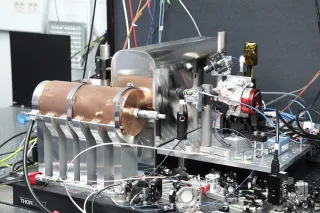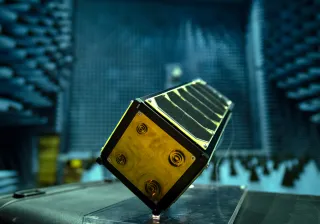Researchers at VTT have succeeded in making data collected on NASA’s Mars mission more accurate by using mathematics. As a result of VTT’s error compensation model, the accuracy of relative humidity measurements significantly exceeded mission requirements. This massive reduction in uncertainty means that planetary scientists and other researchers around the world can now benefit from this measurement data as they study questions ranging from Mars’ atmosphere and water cycle to its historical habitability.
Image:NASA/JPL-Caltech
Since landing on Mars in February 2021, Nasa’s Perseverance rover has been collecting data that could help answer crucial questions about Mars and help us better understand also our own home planet. Attached to the rover, a weather station full of advanced technology, including humidity and pressure sensors developed by Finnish Meteorological Institute (FMI) based on Vaisala sensor technology, conduct around-the-clock measurements on temperature, wind speed and direction, pressure, relative humidity, and the size and amount of dust particles.

Image:NASA/JPL-Caltech
Designing technology that can withstand a rough landing and remain reliable even in the extreme conditions of Mars is difficult. But even after successful measurements, researchers are faced with an additional challenge: assessing the accuracy of the data.
To ensure best possible data for researchers”, a team at VTT MIKES, the National Metrology Institute of Finland, in cooperation with FMI worked to estimate and reduce uncertainty levels of the measurements.
“Knowing that the data we have is accurate and reliable is what makes it useful. If we don’t know how accurate our data is – if it could be off by one, five or twenty-five percent - we cannot use it to draw any conclusions. This is true for everyday measurements done on Earth as well as those done on planet Mars,” explains Richard Högström, research team leader at VTT MIKES.
Researchers at FMI have been studying Mars’ atmosphere already for decades and FMI has participated in several Mars missions. Now, with a new weather station aboard Perseverance, more information than ever before is gathered and made available to researchers and enthusiasts around the world through an open database.
“Eventually, we want to be able to forecast weather on Mars, but it is not an easy task. We need to be able to combine data from different instruments and make comparisons to data collected on Earth. Reliability is crucial. When we first reached out to VTT, the goal was just to estimate uncertainty levels, but on top of that, they were able to considerably reduce the uncertainty. This has been a great success,” comments Maria Hieta, research engineer from FMI.
Researchers at VTT MIKES used a wide range of experimental data as well as new data analysis techniques to address the associated uncertainty levels and provide traceability to the international system of units (SI). Even with decades of experience and expertise in humidity measurements, work on data from Mars presented unprecedented challenges.
“The conditions like temperature and pressure on the dusty red planet are extremely demanding. By monitoring the cross-sensitivity sources, providing a compensation model, enhancing the gas mixture theoretical equations, and eventually using dynamic analysis of the sensors, we were able to significantly lower the level of uncertainty. Maybe one day this data will help us prepare for a human settlement on Mars,” says Shahin Tabandeh, senior scientist in thermal metrology at VTT MIKES.
Link to the database
PDS (Planetary Data System): The Planetary Atmospheres Node
Additional information
Maria Hieta, Research engineer, Finnish Meteorological Institute
[email protected], +358 50 414 6589






